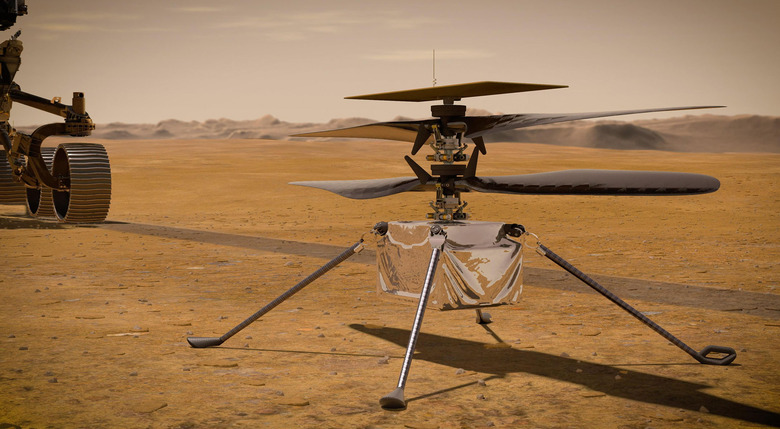NASA's Mars Helicopter Just Took An Extremely Long Flight
NASA is moving fast with its Ingenuity helicopter trials on Mars. In its first flight, the tiny aircraft took off, hovered, and landed in place. Its second flight saw it take off, travel a relatively short distance of 16 feet, and then land again. Its third flight, which NASA completed on Sunday, April 25th, was by far its most impressive trip yet. For the newest test, the helicopter was tasked with taking off to a height of 16 feet and then flying horizontally for 164 feet, or 50 meters. That's over half the length of a football field, and the helicopter nailed it.
What's even more impressive about the flight is the speed at which the helicopter traveled during its horizontal journey. As NASA explains in a new blog post, the aircraft reached a top speed of 6.6 feet per second (2 meters per second) or roughly 4.5 miles per hour. It's not exactly supersonic, but it's speedy enough to make it the fastest machine on Mars by a long shot. For comparison, the Perseverance rover travels at a top speed of less than 0.1 miles per hour.
This latest test is perhaps the best example of why NASA wanted to send a helicopter to Mars in the first place. Ingenuity doesn't have any scientific instruments or goals, but it could help engineers and NASA as a whole to better understand the advantages of sending aerial exploration technology to Mars instead of land-based rovers. The fact that the helicopter safely traveled 50 meters at a speed of 4.5 miles per hour demonstrates that an aerial drone would be able to explore other worlds much faster than robotic rovers.
Via NASA:
The Ingenuity team has been pushing the helicopter's limits by adding instructions to capture more photos of its own – including from the color camera, which captured its first images on Flight Two. As with everything else about these flights, the additional steps are meant to provide insights that could be used by future aerial missions.
The trick, of course, would be to match the speed and safety of an aerial drone with the kind of scientific might that NASA's rovers already possess. A drone that travels for great distances in a short period of time would be great for exploring and mapping out the surface of the planet in greater detail, but if it can't stop and collect samples, analyze them, and send valuable scientific data back to Earth, it's of little value compared to a rover.
Going forward, NASA will have to seriously consider what it wants out of its Mars missions. There are many smart people at the space agency, and combining the scientific power of a rover with the aerial capabilities of an aerial drone could result in the most important Mars exploration mission ever. It'll be many years before such a mission launches if one ever does, but the possibility is looking better and better with each passing day.
